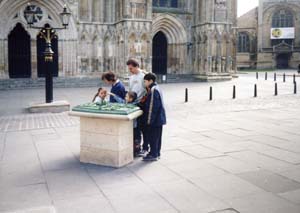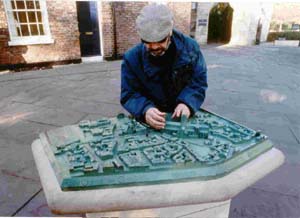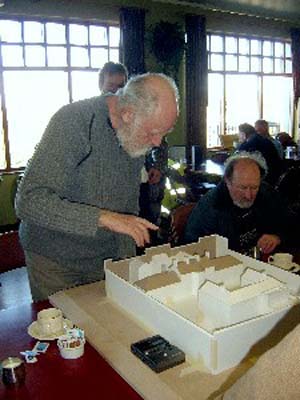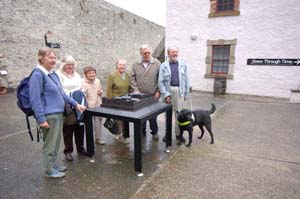Creating Tactile Models
Creating Tactile ModelsTactile models
Introduction
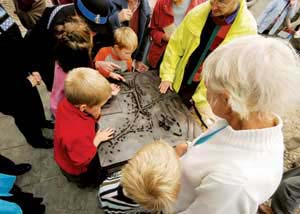 The Dog Rose Trust has been involved in the production of tactile scale models for many years. While these models have Braille and clear lettering on them, they are for everyone to use. People who are blind and visually impaired say that a tactile model gives them the best idea of a building or environment. But a tactile model is very popular with everyone, as can be seen with the model of the Norfolk town of Wymondham, as it gives the user information about the size, shape and character of a building or place. | ||
| ||
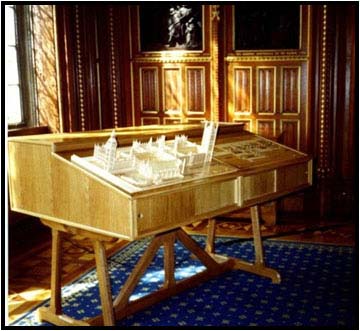 The material used for the model needs to be robust enough to stand up to handling but suitable for its surroundings. For the Palace of Westminster, shown here in the Queen’s Robing Room, only wood was appropriate; the stand had to be specially designed to fit with the Pugin interiors. For outdoors bronze is, at present, the only material that will withstand constant use, weather and vandalism. | ||
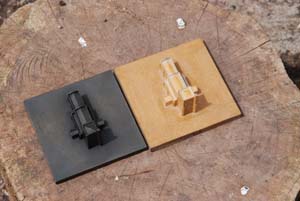 Commissioning and making a tactile model Despite this popularity with users, it is not easy to get clients to commission tactile model; most clients like the idea but not the cost. There is no escaping the fact the tactile models cost money as initial designs have to be drawn and much of the work is carried out by hand, but technology is changing all that. See the paragraph on The Future at the end. We have set out the steps that we have taken during the commissioning of some of our models.
1. We are generally approached by a client to give an estimate of cost for the model so that they can raise funds for it. The longer this takes, the more the cost might rise.
2. We ask the model maker and caster, if required, to give budget prices for a range of options and materials so that the client can decide what they want to spend.
The options could be:
a. Wooden three dimensional model of the building. For indoors only
b. Small wooden three dimensional model of the building with a ground plan. For indoors only
c. A cast resin three dimensional model: for this a wooden model has to be built first. The client therefore ends up with two models. For outdoors depending on the material used.
d. A cast bronze three dimensional model: for this a wooden model has to be built first. The small church in both wood and bronze illustrate this. The client therefore ends up with two models. For outdoors this method is very heavy and durable.
e. C and D above can also have ground plans as for the Palace of Westminster model.
| ||
| ||
| ||
| ||
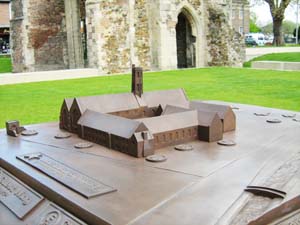 The addition of Braille and lettering Lettering and Braille can be an integral part of manufacture of the model when it is cast or they can be added on after the model is made. It is necessary to ensure that there is enough space on the model for the names to be added.
We use Grade 1 Braille which is letter for letter as more people can read this as on this bronze model of Greyfriars in King’s Lynn. | ||
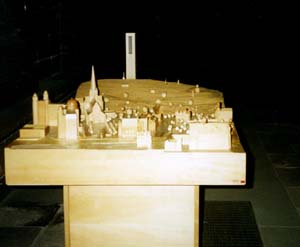 The addition of sound Sound is a help to a range of users and adds atmosphere and character to the model. It can be accessed through a headset or by speakers depending on where is it situated, but it is not easy to provide for outdoor models. It is not impossible but would be expensive to waterproof and make secure.
The sound can be activated either by touching a place on the model, via a computer programme or by pressing a button with the audio on a sound store. The original Dorcas Project, developed by the Dog Rose Trust used infra-red for the sound, as on this wooden model of Glasgow Cathedral Precinct. | ||
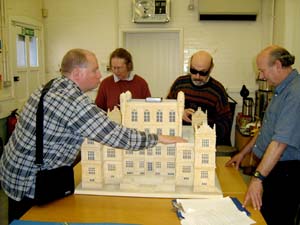 The audio commentary should reflect the character and sound of the building and if possible be recorded in the spaces being described. The tracks should be informative but short. Two blind colleagues tried out the commentary for the model of Woollaton Hall and made many useful comments. | ||
The Future Currently the Trust is involved in several research programmes that will certainly affect the future of tactile models.
For example, digital survey techniques should make accurate surveys more comprehensive and exact. Prototype modelling techniques are being experimented with to make the tactile models. Research into sound activated by sensors and transmitted in new ways are under review.
Ambient information systems are becoming part of the new inclusive designs.
There is more information about our work on other models and tactile plans on this project page.
The Dog Rose Trust
06 January 2009 | ||


